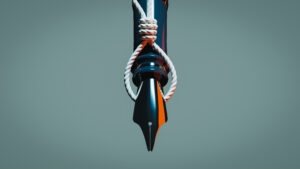Harlan Crow’s Nest of Nazi Artifacts
An investigation into the GOP mega-donor's controversial collection of historical relics. A Nazi statue at the Interpol headquarters in Buenos Aires, Argentina. (AP Photo/Natacha Pisarenko)
A Nazi statue at the Interpol headquarters in Buenos Aires, Argentina. (AP Photo/Natacha Pisarenko)
Who is Harlan Crow? As questions mount about Supreme Court Justice Clarence Thomas’s alleged failure to disclose significant gifts (and attendant concerns about his integrity multiply), his principal benefactor has achieved a certain, curious fame. Until recently Harlan Crow, despite his enormous wealth and influence, remained a relatively obscure Dallas billionaire. Now, many want to know why he has lavished so many gifts on Justice Thomas, including a Bible once owned by the great abolitionist Frederick Douglass, an invaluable piece of Americana and an American relic.
For me, and for many others, the most fascinating aspect of Crow’s new celebrity is his controversial penchant for collecting rare,— and sometimes disturbing—historical objects. These include things we might call “atrocious relics.” In my recent book, American Relics and the Politics of Public Memory, I wrestle with such matters. Why do we collect relic-like things? What do they mean? What do they “do” or “say”—to those who possess them and to those who view them? Relics can be whimsical, glorious, or sober, but they are also volatile and sometimes alarming and offensive.
Relic is commonly defined as a material object held in reverence by believers because it is linked to a holy person. In medieval Christendom, relics—blood and bones of saints, pieces of the “true cross,” and other sacred traces—gave power to their possessors and access to the divine. Their presence elevated and sanctified churches and communities, helped mold worshippers’ identities, and fixed them in a larger Christian world.
Important public relics seemingly possess an ability to speak firsthand, to communicate authentically, wordlessly, emotionally, compellingly.
In our more secular modern world, relics endure and perform some of the same functions. Prized vestiges of former times, souvenirs or mementos connect us directly to the past. They do not merely illustrate it; they physically embody it, its glory and triumph, sometimes its tragedy or even horror. Relics are the past, persisting in our present.
Important public relics seemingly possess an ability to speak firsthand, to communicate authentically, wordlessly, emotionally, compellingly. They are both the argument and the evidence, veritable “smoking guns.” Sometimes they look ordinary. Who cares about some old, unremarkable fountain pen, until we learn that Lincoln used it to inscribe the Emancipation Proclamation in 1863? What’s the big deal with some old, tattered book, until it’s revealed as the Bible once owned (before Crow and Thomas) by Frederick Douglass? Through such things, we are uncannily linked to “history.”
Harlan Crow has accumulated lots of such stuff at his Highland Park estate—astonishing stuff—including (randomly) a letter written by Christopher Columbus, a silver tankard crafted by Paul Revere, the deed to George Washington’s Mount Vernon, Dwight D. Eisenhower’s helmet, adorned with five stars, a cannonball from the Battle of Gettysburg, and much, much more.
But mingled among these American treasures are linens, medallions, and other Nazi artifacts and memorabilia, as well as an autographed copy of Hitler’s hateful tome Mein Kampf and two of his paintings, landscapes distinctive because of their artist, not their artistry. The manor’s grounds include a sculpture park arrayed with statues of notorious Communist leaders, a so-called “garden of evil” populated by Marx, Lenin, Stalin, Tito, Castro, Ceausescu, and other villains perhaps more obscure but nonetheless malignant, such as Gavrilo Princip, the assassin of Archduke Franz Ferdinand who precipitated World War I.
Why would Harlan Crow harbor such things? Of course, they are rare and valuable commodities, which might command a considerable price if sold, and which conspicuously display the inestimable fortune of their possessor. They are the prizes of Crow’s wealth. But his collection is not merely an investment, uncurated, or randomly compiled. These things hold meaning beyond their financial valuation, and they help define the man who owns them. If Crow tells stories through them, they tell stories about him.
It’s not really possible to renovate disgraced public monuments, unlike structures or institutions saddled with an unfortunate name, which can be changed and repurposed.
Maybe Crow’s despots in bronze and stone function like big game trophies, displaying dominance over one’s quarry or foes. Or maybe they are a snarky, conservative troll to antagonize liberal critics, representing Crow’s supremacy over his opponents. They allow him, literally, to crow. Defenders argue their benign didacticism, marking the triumph of good over evil and reminding us of what to hate. In fact, new sorts of institutions—memorial museums—emerged after the Second World War that were designed to confront evil, to teach, memorialize, and heal in the wake of cataclysms, the Holocaust most prominently. But these institutions commemorate victims, not perpetrators like those assembled by Crow. Despite the rationales, Crow’s garden of evil does not teach or heal. It pays implicit homage to the evildoers and their power, deadening viewers to the full measure of their horrific ideas and acts.
It’s not really possible to renovate disgraced public monuments, unlike structures or institutions saddled with an unfortunate name, which can be changed and repurposed. Fort Benning recently became Fort Moore; Fort Bragg, Fort Liberty; Fort Hood, Fort Cavazos. But a statue of Robert E. Lee or Josef Stalin is inescapably a statue of Lee or Stalin. Neither can be rehabilitated by unilaterally rechristening them Martin Luther King or Lech Walesa. Crow doesn’t try and likely doesn’t care.
Crow’s unnerving monuments and memorabilia connect us to a reprehensible past, revivifying that which is sinister and frightening and, even for Crow perhaps, sordid and shameful. As one visiting reporter noted, the Nazi artifacts are placed in cabinets, “out of the view of visitors,” controlling their ability to “say” indiscreet things. Such materials evoke the lynching postcards and other grisly souvenirs once prized by white supremacists, kept privately as racist talismans. Broader public scrutiny transformed them into appalling objects, atrocious relics. Recent revelations thus pose some uncomfortable questions. Has Crow collected Thomas? And what do his relics say about him, and about us?
Your support is crucial…With an uncertain future and a new administration casting doubt on press freedoms, the danger is clear: The truth is at risk.
Now is the time to give. Your tax-deductible support allows us to dig deeper, delivering fearless investigative reporting and analysis that exposes what’s really happening — without compromise.
Stand with our courageous journalists. Donate today to protect a free press, uphold democracy and unearth untold stories.










You need to be a supporter to comment.
There are currently no responses to this article.
Be the first to respond.